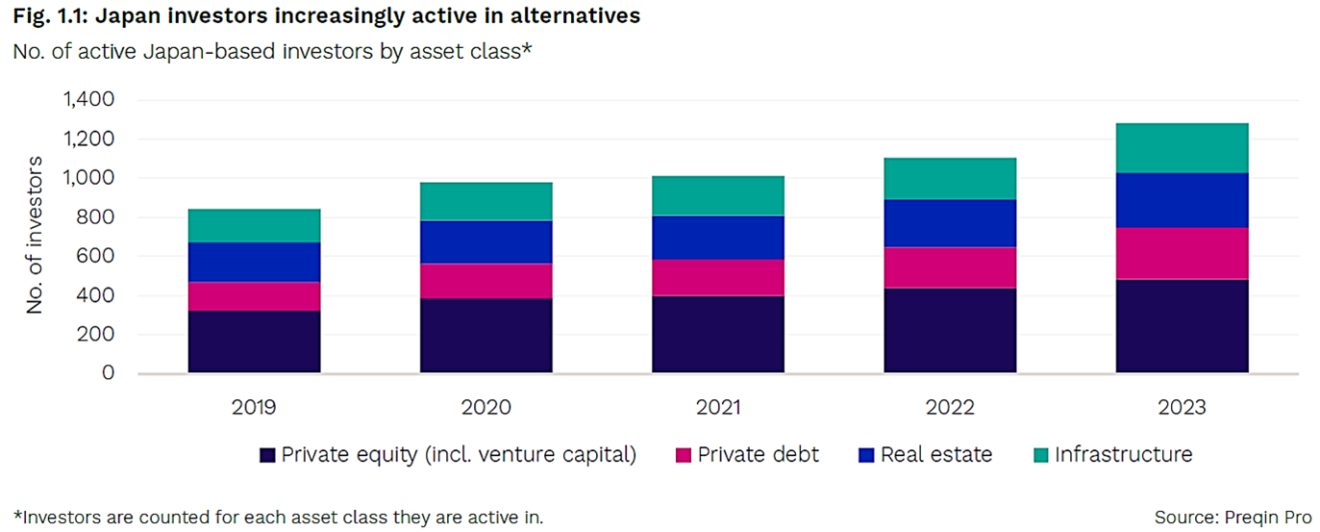
This article forms part of a series of articles examining the opportunities Japan presents for investment managers. It focusses on the opportunities presented by Japanese institutional and retail investors.
Japanese investors are progressively increasing their exposure to private equity, private credit, infrastructure, real estate and other alternative asset classes (collectively “alternative investments”).

The move towards alternative investments is influenced by a combination of factors, including the reemergence of inflation to Japan, the pursuit of higher yields and the implications of a declining population.
Current landscape and challenges
As of June 2023, Japan-based private capital funds manage assets totaling US$115 billion, according to Preqin data[1]. This figure includes foreign investments but represents only about 4% of Japan’s pension fund assets[2]. This proportion is insufficient to satisfy the investment needs of all Japan-based investors, prompting them to allocate funds to international managers in the US, EU, and beyond.
Retail investors and government initiatives
Japanese households possess approximately US$14 trillion in assets as of June 2023, with half of this amount held in cash and deposits[3]. In stark contrast, US households keep a mere 13% in similar liquid forms.[4]
The Japanese government aims to double household investment income and is actively promoting investment through the expansion of the Nippon Individual Savings Account (NISA), a tax-exempt investment scheme for individuals. The Japan Securities Dealers Association reported a surge in new NISA accounts, with over half a million opened in February 2024[5].
The recent authorisation for investment trusts to include unlisted shares in NISA portfolios is anticipated to enhance retail access to alternative assets. The Maples Group’s Asia practice has recently advised on the public offerings of several Cayman Islands unit trusts in Japan that invest in Blackstone’s flagship funds, such as Blackstone Real Estate Income Trust (BREIT), Blackstone Private Credit Fund (BCRED), and Blackstone Private Equity Fund Strategies (BXPE). This substantial savings reserve offers a considerable new prospect for both domestic and international asset managers.
Institutional investors and market dynamics
The growing interest in Alternative Investments among Japanese institutional investors has been providing substantial opportunities for managers for some time. The diversity of Japanese institutional investors and asset classes has expanded in recent years, drawing increased attention from international managers. Prominent US firms, including Blackstone, Brookfield, Apollo, and KKR, have already established a presence in Japan.
Japan’s rapidly aging population is likely to further drive institutional investors, such as pension funds and life insurers, toward Alternative Investments. Currently, 29.1% of Japan’s population is aged 65 or older, a figure projected to exceed 34.8% by 2040[6].
Types of investment vehicles used by Japanese investors
Japanese investors utilise a diverse array of investment vehicles across various jurisdictions, with the Cayman Islands commanding a market share of more than two-thirds (67.3%) of Japanese investments in overseas investment funds[7]. The unit trust and the exempted limited partnership (ELP) are the investment structures of choice for Japanese investors in the Cayman Islands. The different structures offer distinct advantages that suit different needs. The ELP is established as a contractual arrangement between the general partner who conducts the business of the ELP and passive investor limited partners and is particularly well-suited for situations where contractual flexibility and tax transparency are paramount. The development of the law in this area has been informed by the demands of the private equity market and are generally flexible enough to accommodate variation in a range of terms as negotiated between the general partner and the limited partners. Further, the general partner is often a special purpose vehicle established by the asset manager thereby permitting the asset manager to manage the ELP without the need to involve a third-party operator. The surge in interest in Alternative Investments has led to the development of a novel unit trust investment vehicle which has become very popular in the market with certain institutional investors, the Private Equity Type Unit Trust, the details of which are provided below. Often, a Private Equity Type Unit Trust will channel investments into an international manager’s limited partnership investment fund, creating a layered investment strategy that leverages the strengths of both vehicles.
Japan is also a significant user of Luxembourg and Ireland for publicly offered funds, especially UCITS. This trend is expected to grow as the population ages. Japanese institutional investors, diversifying into Alternative Investments in Europe, are increasingly favoring fund structures in Luxembourg, Ireland, and Jersey. Many large Japanese institutional investors have established fund vehicles in these jurisdictions, a trend that is expected to continue.
The rise of the private equity type unit trust
The burgeoning interest in alternative investments by institutional investors has led to the swift adoption of the ‘private equity type’ unit trust (the PE Type Unit Trust). This Cayman Islands unit trust, favoured by many Japanese institutional investors, embodies certain private equity fund features, such as capital call provisions and defaulting investor clauses. The PE Type Unit Trust structure offers several benefits for investors seeking exposure to Alternative Investments, including but not limited to:
- Investor Familiarity: The Cayman Islands unit trust is a well-established and popular vehicle among Japanese investors for accessing complex investment strategies;
- Tax Advantages: Investors can often achieve securities investment trust tax status in Japan with this structure;
- Off-Balance Sheet Accounting: For accounting purposes, the PE Type Unit Trust is considered an off-balance sheet entity, eliminating the need for account consolidation; and
- JPY Hedging: Many Japanese investors prefer to hedge against non-JPY currency exposure from non-JPY denominated Alternative Investments. The PE Type Unit Trust structure facilitates this by allowing for the distribution of both realised and unrealised gains and providing a current net asset value for hedging purposes. This contrasts with the limited partnership structure, where gains or losses are not recognised until the investment is realised, potentially delaying hedging activities.
[1] Fundraising from Japan 2024: A guide to raising capital
[2] https://www.boj.or.jp/en/statistics/sj/index.htm
[3] https://asia.nikkei.com/Economy/Japan-households-financial-assets-hit-record-14tn-on-stock-rally
[4] Financial Times article dated 14 December 2023 “Can Japan’s Legendary Savers Spark a Stock Market Boom”.
[5] Financial Times article dated 8 April 2024, “Is Japan finally becoming a ‘normal’ economy?”
[6] National Institute of Population and Social Security Research
[7] Japan Ministry of Finance, Regional portfolio investment positions, end of 2022

Nick Harrold is a partner in the Singapore Funds & Investment Management team at Maples and Calder


